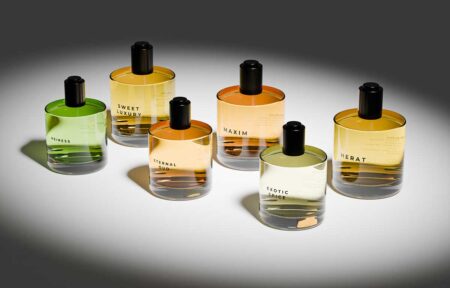Natural perfumes are extremely popular due to their eco-friendly appeal, delicate compositions, and aromas. Unlike synthetic scents, these perfumes are made from plant extracts, essential oils, and natural ingredients, which smell great and stay longer. Each ingredient contributes a distinct charm, resulting in scents that are exquisite, authentic, and in harmony with nature.
In this post, we will look at some of the most popular natural perfume ingredients and how they help to create long-lasting, distinctive aromas.
Top 7 Natural Ingredients for a Long-Lasting Perfume Scent
When it comes to crafting long-lasting perfume for women, these natural ingredients are the top choices for perfumers –
1) Jasmine
Jasmine, a fragrant white flower, is a key ingredient in women’s perfumes. Known as “La Fleur” in the fragrance world, it has nearly 200 varieties, but Jasminum grandiflorum and Sambac Jasmine are the most prized. The former, often grown in Grasse, is favored by luxury brands like Chanel, while Sambac Jasmine adds depth to popular scents.
Extracting jasmine is labor-intensive; 8,000 blooms are needed for just one milliliter. This delicate process makes jasmine one of the costliest perfume ingredients. While its scent varies by region—from sweet to musky—synthetic alternatives offer affordability, though they lack the natural richness of true jasmine.
2) Oud
Oud, often liquid gold, is a rare and costly perfume ingredient. Its scent divides opinions—people either adore it or find it overwhelming. Oud comes from resin formed by a fungus infecting the Aquilaria tree’s wood. This agarwood resin produces a rich, woody aroma.
Oud’s bold fragrance enhances other perfume notes, requiring expert pairing. Fans of oud cherish its bittersweet, earthy, and sensual character. Its longevity depends on the resin’s type, age, and amount. Once rooted in Arabic and Indian traditions, oud is a prized global favorite, with synthetic versions imitating its unique allure.
3) Citrus
Citrus smells are lively and invigorating, made from grapefruit, yuzu, and lemongrass. These notes, which are commonly removed during cold pressing, preserve their zesty flavor. Citrus is a classic top note in perfumes that conveys a sensation of brightness and clean simplicity, similar to sunny mornings.
It balances floral aromas by lowering their sweetness and works well with spicy or resinous notes in oriental mixtures. Citrus’ vibrant acidity provides a playful yet elegant touch, making it a versatile element that elevates and enhances a wide range of aroma characteristics, creating a lasting sense of freshness and sophistication.
4) Cedarwood
Cedarwood has a warm, woody, and somewhat musky amber aroma, making it a classic option in perfumery. As one of the oldest scent constituents, it provides a grounded freshness. Its adaptability shines through, complementing both strong macho and subtle feminine perfumes. Cedarwood oil, extracted by steam distillation from the wood, roots, and leaves, has a delicate balsamic scent.
This dry, woody note improves citrus, floral, and spicy blends by providing depth and balance. Its relaxing nature balances harsh smells, resulting in harmony. Cedarwood, a common ingredient in perfumes, adds strength and character to any mixture, leaving a lasting impression. Ideal for timeless sophistication.
5) Patchouli
Patchouli, a key ingredient in perfumes, is cherished for its earthy, woody scent. Extracted from the leaves of an Indian bush, this oil has a unique aroma that improves with age, gaining fruity and balsamic undertones. Its history dates back to Napoleon’s era and became iconic in the 60s and 70s.
Patchouli oil’s quality depends on precise cultivation, harvesting, drying, and distillation. Just a few mature leaves yield the finest oil. It blends effortlessly with scents like sandalwood, vetiver, and lavender, making it a cornerstone of chypre, oriental, and fougère fragrances. Patchouli’s complexity adds depth to many perfumes.
6) Sandalwood
Sandalwood, a smooth woody scent, is cherished for its lasting fragrance. Revered in Asian traditions, its sweet aroma beautifully pairs with floral notes. Known for its enduring essence, sandalwood often serves as a base note in perfumes, symbolizing vitality in Indian beliefs. Its fixative properties enhance other ingredients, making it invaluable in fragrance creation.
In aromatherapy, sandalwood oil is popular for its soothing qualities and is also considered an aphrodisiac. Perfect for romantic moments, a sandalwood-infused perfume leaves a memorable impression. Let its timeless charm elevate your next special occasion with warmth and elegance.
7) Amber
Amber, often called “tears of the sun” or “hardened honey,” is a fossilized plant resin that forms over millions of years. Found in various colors, it is cherished for ornaments and perfumes. Amber is a keynote in oriental fragrances, giving rise to the “amber Orientals” category. Blended with aldehydes, sandalwood, galbanum, and vanilla, it creates a warm, powdery, and sensual scent.
Ambergris, its synthetic counterpart, delivers a smooth, lasting sweetness. Amber’s deep character gently lingers, fixing floral notes into enduring aromas. Its cozy and captivating qualities make it a timeless choice in perfumery, evoking warmth and sophistication.
Essential Oils and Extracts: The Heart of Natural Perfumes
The longevity and appeal of natural perfumes also depend on the quality of their carrier oils and extracts. These ingredients are functional and enhance the overall experience.
1) Jojoba Oil – Jojoba oil is a popular choice for natural perfumes as it mimics the skin’s natural oils, ensuring fragrance blends seamlessly and lasts longer.
2) Apricot Oil – This lightweight oil is an excellent carrier for essential oils, allowing the perfume to be easily absorbed into the skin without being greasy.
3) Coconut Oil – This oil enhances the fragrance’s longevity while adding a faint tropical sweetness, making it perfect for floral and fruity scents.
4) Vitamin E (Tocopherol) – Vitamin E is a natural preservative that extends the shelf life of perfumes. It also nourishes the skin, adding a touch of care to the aromatic experience.
5) Blueberry Extract – Blueberry extract, rich in antioxidants, protects the skin and imparts a subtle fruity nuance to perfumes, making it a versatile addition.
Overview: Popular Natural Elements in Fragrances
Natural perfumes are crafted with a harmonious blend of essential oils, carrier oils, and botanical extracts. Ingredients like jasmine, oud, citrus, cedarwood, patchouli, sandalwood, and amber form the backbone of long-lasting scents, while carrier oils such as jojoba and apricot enhance their performance.
Whether you are drawn to floral, woody, or citrusy fragrances, natural perfumes provide a perfect balance of luxury and sustainability, offering an unforgettable aromatic experience.






